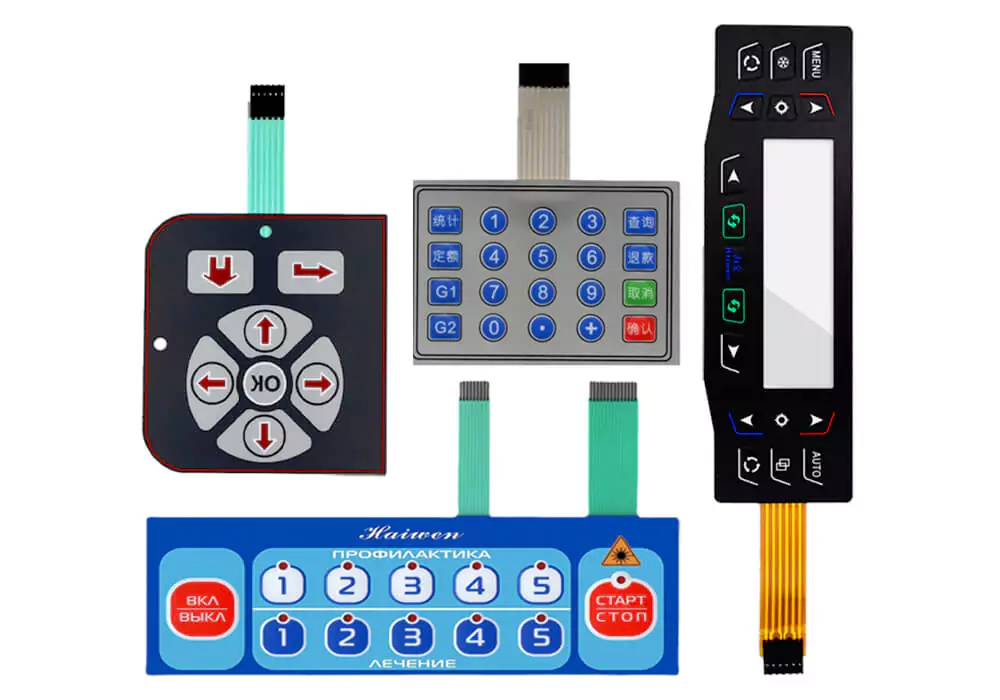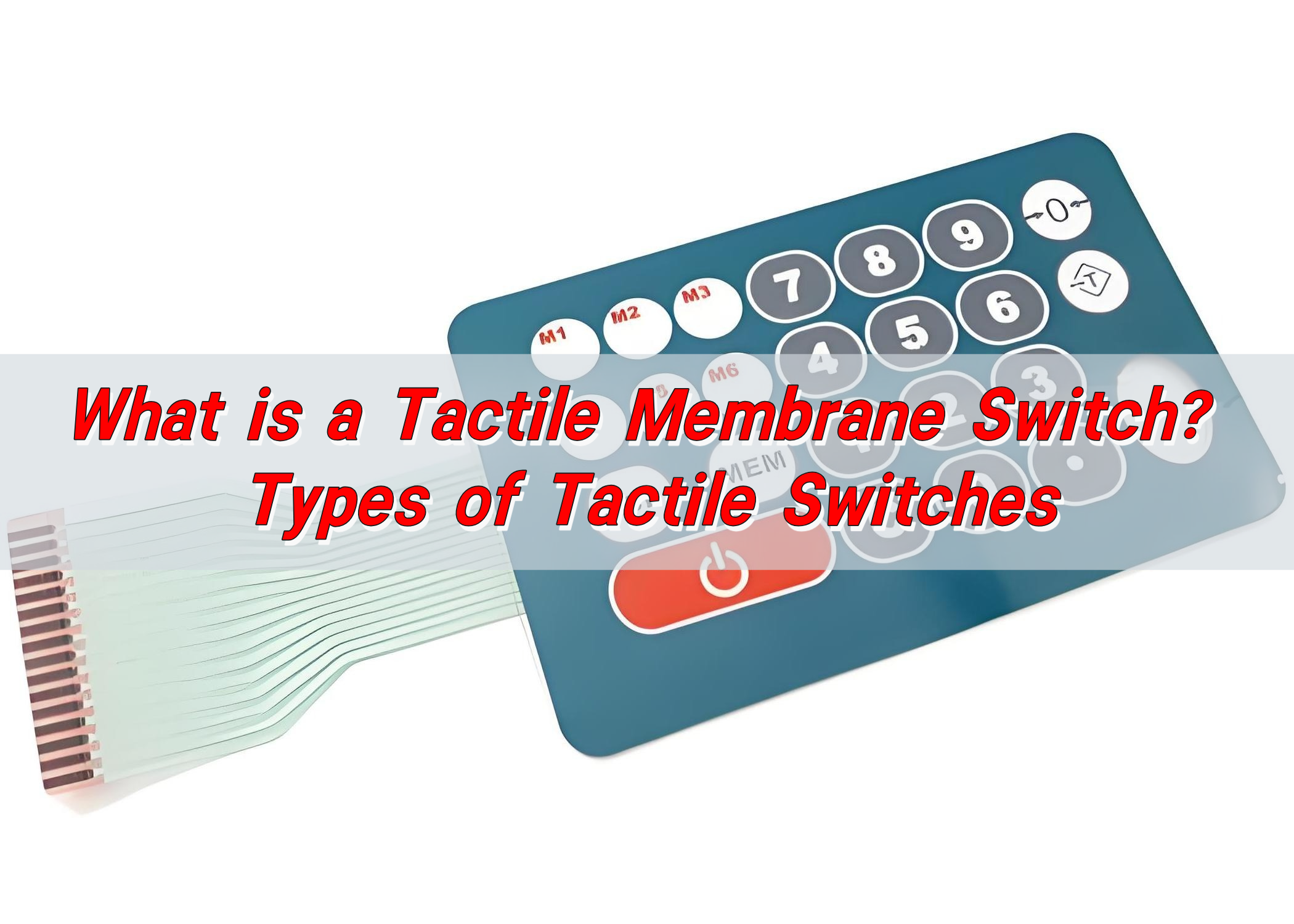How membrane switch is a game changer in aerospace control systems
Wiki Article
Everything About Membrane layer Change: A Comprehensive Overview for Beginners
Membrane layer switches are important parts in modern-day electronic devices, offering an unique interface for individual communication - membrane switch. Their layered construction, consisting of overlays and conductive traces, gives capability and toughness. Unlike standard mechanical buttons, membrane layer buttons provide a sleek layout and customizable options. Understanding their vital features and advantages can change item design. The ins and outs of their application and design considerations require more exploration.What Is a Membrane layer Change?
A membrane button is a sort of electric switch that contains a flexible membrane layered over a published circuit board. This style permits for a sleek and portable user interface, frequently made use of in different digital tools. Membrane switches are frequently found in consumer home appliances, clinical tools, and industrial equipment as a result of their sturdiness and resistance to ecological factors.The construction normally consists of numerous layers, such as visuals overlays and adhesive backing, which give tactile comments and secure the circuitry beneath. The procedure of a membrane layer button is started when stress is put on the surface, completing an electrical circuit.These switches are valued for their flexibility, enabling customized styles and published graphics that cater to particular individual interfaces. Their low-profile nature decreases area demands, making them excellent for applications where traditional buttons might not fit. Overall, membrane layer switches provide a aesthetic and functional remedy for modern-day digital gadgets.Secret Components of Membrane Changes
Membrane layer changes comprise several vital elements that add to their functionality and performance. The leading layer, called the overlay, gives the interface and is frequently printed with graphics or symbols. Below the overlay lies a spacer layer, which divides the conductive components and stops inadvertent activation. The next essential element is the graphic layer, which boosts visual appeals and guarantees the resilience of the design.Conductive traces, typically made from products like silver or carbon, are published on the circuit layer. When stress is related to the overlay, these traces enter into call, completing the circuit. Furthermore, a backing layer supplies architectural support and can be made from products such as polyester or polycarbonate. Together, these elements produce a trustworthy, straightforward interface ideal for various applications, from house devices to industrial tools. Comprehending these components is necessary for any person curious about membrane layer switch innovation.Just How Membrane Switches Over Work
Comprehending how membrane layer changes feature is important for valuing their prevalent usage in different tools. A membrane button runs via a collection of layers, including a graphic overlay, spacer, and a circuit layer. When stress is put on the overlay, it presses the spacer layer, enabling the circuit layer to make get in touch with and complete an electrical circuit. This activity sends a signal to the gadget, motivating a reaction, such as turning on a light or turning on a function.Membrane switches can be developed with different attributes, including responsive responses, backlighting, and custom graphics, improving individual interaction. Their building and construction permits for a covered design, protecting the internal elements from dust, wetness, and pollutants. This toughness makes them suitable for diverse applications, from consumer electronics to industrial tools. On the whole, the simpleness and performance of membrane layer switches over contribute to their popularity in modern-day innovation.Benefits of Membrane Switches Mechanical Switches
While mechanical switches have actually long been a staple in lots of tools, membrane layer switches over deal unique benefits that make them increasingly appealing. One significant benefit is their slim account, enabling more small designs and greater adaptability in item development. Additionally, membrane layer switches over function a consistent surface area, which boosts aesthetic appeal and streamlines cleaning, making them suitable for settings where hygiene is critical.Another advantage is their resistance to dirt and moisture. Unlike mechanical buttons, which can be compromised by ecological elements, membrane layer switches give a closed user interface that safeguards versus contaminants - membrane switch. Membrane switches generally have a longer life-span due to fewer relocating parts, resulting in boosted sturdiness and reliability.Cost-effectiveness is also a remarkable advantage, as membrane layer buttons can be created in mass with reduced manufacturing prices. These elements incorporate to position membrane layer buttons as a useful alternative to traditional mechanical options in various applicationsCommon Applications of Membrane Layer Switches
Membrane layer switches are widely used in numerous sectors, particularly in customer electronic devices and industrial control board. In consumer devices, they supply a streamlined, easy to use user interface, while in commercial settings, they enhance sturdiness and functionality. Comprehending these applications highlights the convenience and practicality of membrane layer switches in modern-day innovation.Consumer Electronics Instruments
As consumer electronics proceed to progress, membrane layer buttons have actually become a popular option for a range of devices as a result of their convenience and streamlined layout. These buttons are commonly found in smartphones, tablets, and push-button controls, where area is restricted and visual appeals matter. Their low profile and customizable designs allow manufacturers to create user-friendly user interfaces that boost the general user experience. In addition, membrane buttons are usually used in home this contact form appliances such as microwaves and coffee machine, supplying user-friendly control alternatives while withstanding moisture and dust. The longevity and reliability of membrane switches over make them suitable for daily consumer items, guaranteeing longevity and regular performance. Overall, their combination in consumer electronic devices shows a blend of capability and contemporary style.Industrial Control Panels
The applications of membrane layer changes extend past consumer electronic devices, discovering considerable usage in industrial control board. These buttons are favored for their durability and resistance to extreme environments, making them suitable for producing and process control setups. They give a reliable interface for operators to regulate machinery, screen procedures, and change settings. Membrane layer buttons can be customized to match details operational needs, integrating features like backlighting and responsive feedback, improving customer experience. Their low-profile layout enables combination right into various tools, while their ability to endure spills, dust, and extreme temperature levels guarantees durability. In general, membrane switches add to efficient and risk-free operation in commercial applications, showing their flexibility and efficiency in demanding atmospheres.Factors To Consider for Creating Membrane Changes
When designing membrane switches, choosing the appropriate products is important to ensure toughness and performance. Furthermore, comprehending layer arrangement strategies can substantially affect the switch's performance and customer experience. These considerations play an important function in producing reliable and trusted membrane layer button styles.
Product Option Significance
Product choice plays an important role in the layout and functionality of membrane layer switches. The picked products directly impact the button's toughness, responsive reaction, and total aesthetic. Secret considerations include the substrate, which have to give structural stability while enabling for flexibility, and the graphic overlay, which needs to be immune to wear and environmental factors. Conductive materials need to guarantee trustworthy electrical performance, while adhesives need to offer strong bonding without endangering the button's operation. In addition, compatibility with making procedures and end-user settings is crucial; materials need to hold up against varying temperature levels, moisture levels, and chemical direct exposure. Inevitably, suitable material choice not only enhances the membrane button's performance but likewise adds to its longevity and user fulfillment, making it an important element of the style procedure.
Layer Arrangement Strategies

Frequently Asked Concerns
For How Long Do Membrane Changes Typically Last?
Membrane switches usually have a lifespan of 1 to 5 million cycles, depending upon use and ecological conditions. Elements such as layout high quality and operating regularity substantially affect their resilience and general performance durability.
Can Membrane Layer Changes Be Personalized for Certain Layouts?
Membrane layer switches can undoubtedly be tailored to accommodate specific layouts, enabling varied shapes, colors, and capabilities. This adaptability enables suppliers to customize these buttons to meet special visual and operational requirements efficiently.What Products Are Made Use Of in Membrane Layer Change Construction?
Membrane switches are normally constructed making use of materials such as polyester, polycarbonate, and sticky layers. These materials give toughness, flexibility, and resistance to ecological factors, making sure the buttons function efficiently in numerous applications and conditions.
Are Membrane Layer Switches Over Resistant or waterproof to Wetness?
Membrane layer buttons can be made to be moisture-resistant, utilizing specialized finishes and products. Nevertheless, their water-proof capacities depend on building and construction quality and certain applications, making it necessary to evaluate demands for optimal efficiency in numerous settings.Exactly How Are Membrane Changes Fixed if Harmed?
Repairing damaged membrane changes normally includes replacing the impacted layer or circuit. Service technicians may likewise apply conductive adhesive or utilize specialized repair work kits, ensuring functionality is brought back without full substitute of the whole button assembly. Unlike traditional mechanical buttons, membrane switches present a streamlined style and customizable alternatives. A membrane layer button is a type of electric button that consists of an adaptable membrane layered over a printed circuit board. The procedure of a membrane layer button is initiated when pressure is used to the surface area, completing an electrical circuit.These switches are valued for their versatility, making it possible for personalized styles and printed graphics that provide to specific user interfaces. While mechanical buttons have long been a staple in many gadgets, membrane layer switches over offer distinctive advantages that make them increasingly appealing. Membrane buttons generally have a longer lifespan due to fewer relocating components, resulting Visit This Link in improved toughness and reliability.Cost-effectiveness is likewise a notable advantage, as membrane layer switches can be generated in mass with reduced production expenses.Report this wiki page